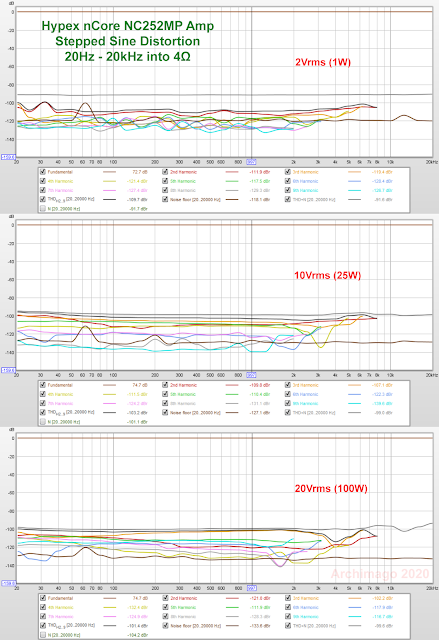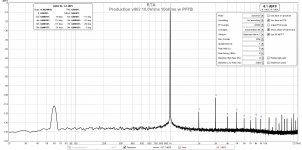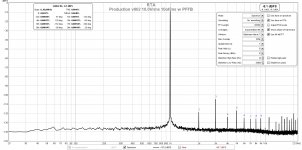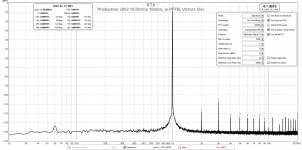I measured the new amp's performance for THD at 1khz and 10W to compare with the TI application note on PFFB for the TPA3255. Table 48 says that at 10W, THD is -93.55dB (or 0.0021%THD). I measured 0.0018% (-94.89dB) using an EBG 10ohm 300w dummy load with a THAT 1646 SE to Bal driver and a Cayin N3 playing a 1kHz Flac file. Here is the FFT for 10w:

Attachments
This was the lead acid battery powering a Dc-DC step up as described earlier. I had some messy cabling that picked up 60Hz EMI.
So one more thing I tried was to remove the Cayin N3 and Fiio A5 from the source chain - they are nice headphone amps, but may actually have more distortion than the TPA3255. So I installed the aboslute best DIY sub-ppm THD 1khz oscillator I could get my hands on: Victor's oscillator (uses 4x 9v batteries and has THD that is basically below the measurable limits of most consumer gear). I used it to directly drive the THAT1646 (which in itself, may have limitations at some point). Surprise! For the reference test case of 10W into 10ohms at 1kHz, I now get 0.0011% THD! Wow!

And just for completeness, here is the 1W case or 3.16Vrms into 10ohms, I now get 0.00074%THD:

Ok, I think my job is done now. This amp rocks, and the performance significantly beats the published specs from TI - probably due to JPS64's layout, the use of a great low distortion output inductor, and other quality parts and fantastic Made in the USA (California) assembly!
And just for completeness, here is the 1W case or 3.16Vrms into 10ohms, I now get 0.00074%THD:
Ok, I think my job is done now. This amp rocks, and the performance significantly beats the published specs from TI - probably due to JPS64's layout, the use of a great low distortion output inductor, and other quality parts and fantastic Made in the USA (California) assembly!
Attachments
I actually ordered the one that xrk recommended and they never ended up shipping it at all. I just canceled the order...Thats fine by me. Biggest issue will be getting the Aliexpress AC/DC SMPS for LEDs. Ordered almost 2 months ago and still hasn't shipped. No doubt due to the coronavirus.
The other option is a 1200w DC-DC step up and use a Pb-acid gel cell or old car/motorcycle/UPS 12v battery. It's good to get these way over rated so they don't work hard. Here is the same one I used to get the super data above.
https://www.amazon.com/KOOBOOK-Step-up-Supply-Converter-Adjustable/dp/B07TB7FBWQ/
And this deep cycle battery:
https://www.amazon.com/dp/B071R9PXVV/
And this battery charger:
https://www.amazon.com/Automatic-Trickle-Battery-Charger-1000mA/dp/B074Z2NFWW/
About $100 all in
https://www.amazon.com/KOOBOOK-Step-up-Supply-Converter-Adjustable/dp/B07TB7FBWQ/
And this deep cycle battery:
https://www.amazon.com/dp/B071R9PXVV/
And this battery charger:
https://www.amazon.com/Automatic-Trickle-Battery-Charger-1000mA/dp/B074Z2NFWW/
About $100 all in
I actually ordered the one that xrk recommended and they never ended up shipping it at all. I just canceled the order...
Actually I did end up getting mine.
Great news and update. Even better news on the performance based on your plots above. Can't wait for it.
All of the units should be completed today. Hopefully will receive them next week. Then comes the task of packaging them and sending them out. I will need to order some boxes.
Distortion rising with frequency on TPA3255 amps
Hi X,
I was wondering if your board found a way to deal with the rising distortion at high frequencies that a lot of the TPA3255 boards have. It showed up in some of drmord's graphs and here is a graph from the Icepower 200AS2 (TPA3255 under the covers).

It doesn't show up in the Hypex NCore NC252MP charts though:

So I wonder if its just a problem inherent to the TPA3255 chip?
Hi X,
I was wondering if your board found a way to deal with the rising distortion at high frequencies that a lot of the TPA3255 boards have. It showed up in some of drmord's graphs and here is a graph from the Icepower 200AS2 (TPA3255 under the covers).

It doesn't show up in the Hypex NCore NC252MP charts though:

So I wonder if its just a problem inherent to the TPA3255 chip?
I’ll have to take a look at it when the rest of the amps show up. I sent my one test unit off for evaluation by another interested party. I never did a sweep vs power at various fixed frequencies.
I’ll have to take a look at it when the rest of the amps show up. I sent my one test unit off for evaluation by another interested party. I never did a sweep vs power at various fixed frequencies.
It was idle curiousity, since I was comparing your amp against the commercial ICEPower 200AS2 board, but I just realized how pervasive this distortion vs frequency issue seems to be.
This is the graph from doctormord's site:

It seems to be pretty consistent for the TPA3255. But it happens on other amps as well, for example the TPA3255 amps do better than the venerable ICEPower 125asx2:
Even some $2500 Nord Hypex amps seem to suffer from it:
So I was curious if all the optimizations you've done on this board effected things.
It could be an issue with the buffer implementation, not necessarily the chip itself.
Take a look at this: https://e2e.ti.com/blogs_/b/analogw...on-got-your-amplifier-down-get-more-bandwidth at the end there is a distortion to frequency graph for OPA836 showing a 70db increase at 20khz.
So you probably need to consider the buffers involved for the graphs as well.
Take a look at this: https://e2e.ti.com/blogs_/b/analogw...on-got-your-amplifier-down-get-more-bandwidth at the end there is a distortion to frequency graph for OPA836 showing a 70db increase at 20khz.
So you probably need to consider the buffers involved for the graphs as well.
I think that what we are seeing is probably more an inherent artifact of Class D topology. Measuring the above data requires something like an AP system or else it’s not an easy measurement. I don’t think it’s an artifact of the input buffers though as those are MHz devices.
I wanted to let folks know about the gain of this amp with PFFB implemented. The TPA3255 nominally has 21.5dB gain (not adjustable). With post filter feedback (PFFB) enabled, the gain is reduced by about 7dB and is specified as nominally 15.9dB in the TI PFFB application note. I have an input RFI filter consisting of 2k2 resistor in series with the input opamp and a 220pF NP0 capacitor shunted to ground. This filter is a 300kHz lowpass and helps to keep radio interference from getting in. It has about a 1.5dB impact on the gain due, and may not be needed if you use the amp in a relatively radio-quiet environment. In such cases, simply install a wire jumper across those input resistors (the very front ones on the bottom of the board) will get your that extra 1.5dB of gain back. If you feel handy, changing those 2k2 for 220R will get you most of the gain back and still afford some RF filtering. Should you want to forego the extra -10dB or so of THD reduction, you can jumper a small wire across the 4 feedback input resistors and you will have a 21.5dB gain amp back. It’s very flexible.
However, the default config is with the 2k2 RFI filter and PFFB enabled. Together, they result in an amp with about 14dB of gain. If you don’t have a balanced drive preamplifier, I have found the $15 Sparkfun THAT1646 breakout boards to work extremely well and are a great value. The just need a low noise +/-15v power supply.
BOB-14003 SparkFun | Mouser
The data presented above was acquired using these boards and a very basic 12v to +/-15v +/-24DCDC step up PSU module from eBay and 7815/7915 regulators. I am not sure if the regulators are needed as the switching is in the MHz range. I think that the +/-15v version might be fine and can be powered from a 5v USB supply.
DC-DC Step-up Boost Converter +-5V +-9V +-12V +-15V +-24V Dual Output Power Supply | eBay
However, the default config is with the 2k2 RFI filter and PFFB enabled. Together, they result in an amp with about 14dB of gain. If you don’t have a balanced drive preamplifier, I have found the $15 Sparkfun THAT1646 breakout boards to work extremely well and are a great value. The just need a low noise +/-15v power supply.
BOB-14003 SparkFun | Mouser
The data presented above was acquired using these boards and a very basic 12v to +/-15v +/-24DCDC step up PSU module from eBay and 7815/7915 regulators. I am not sure if the regulators are needed as the switching is in the MHz range. I think that the +/-15v version might be fine and can be powered from a 5v USB supply.
DC-DC Step-up Boost Converter +-5V +-9V +-12V +-15V +-24V Dual Output Power Supply | eBay
Last edited:
Thanks for this info X. When it arrives, I'll try it out in the default state and implement the mods accordingly. I do have 2 of the SparkFun THAT devices to use depending upon my final configuration of the amp and where I use it.
Off-topic.... Interesting article in the Washington Post today regarding an unsettling twist with potential manifestations of Covid-19 on our bodies. Thought others might like reading about it here.
Stay safe everyone.
Off-topic.... Interesting article in the Washington Post today regarding an unsettling twist with potential manifestations of Covid-19 on our bodies. Thought others might like reading about it here.
Stay safe everyone.
For younger people, the scale of the stroke problem is still quite small - there were a couple of dozen total stroke victims across New York and Philly, and 40% of them were under 50. Compared to the 17,000+ people who have currently died in NYC, its theoretically interesting, but not a huge risk for younger people.
Coincidentally, the first known person to die of Covid-19 in the USA on Feb 6th, actually died of heart failure. She had no travel to China, so she was community infected sometime in January. Its been spreading around silicon valley since at least mid January. A recent estimate is that between 2.5% to 4.5% of the residents in Santa Clara county had covid-19 antibodies as of the early part of this month.
Measuring the above data requires something like an AP system or else it’s not an easy measurement. I don’t think it’s an artifact of the input buffers though as those are MHz devices.
It looks like Archimago was able to get the distortion vs. frequency sweep using REW's "stepped sine" function.

- Home
- Group Buys
- TPA3255 Reference Design Class D Amp GB



